Nestled amidst the rugged grandeur of Pakistan’s Khyber Pakhtunkhwa province, Kumrat Valley stands as a testament to nature’s splendor. As the valley’s popularity as a tourist destination grows, the imperative for responsible real estate practices becomes ever more pressing. This blog delves deep into the intricacies of responsible development in Kumrat Valley, exploring how sustainable approaches can preserve its natural beauty, conserve biodiversity, empower local communities, promote cultural heritage, and ensure long-term sustainability.
Preserving Natural Beauty
The pristine landscapes of Kumrat Valley are its most precious asset, and responsible real estate practices prioritize their preservation. Developers employ careful site selection processes, taking into account factors such as topography, vegetation, and hydrology to minimize disruption to the natural environment. Through sustainable land-use planning and green building techniques, such as low-impact design and energy-efficient construction, developers aim to reduce the ecological footprint of their projects while preserving the valley’s scenic vistas and ecological integrity.
Conserving Biodiversity
Kumrat Valley is a biodiversity hotspot, teeming with diverse flora and fauna that contribute to its ecological richness. Responsible real estate practices in the valley place a strong emphasis on biodiversity conservation, with measures in place to protect critical habitats and sensitive ecosystems. Environmental impact assessments are conducted to identify potential risks to biodiversity, and mitigation strategies, such as habitat restoration and wildlife corridors, are implemented to minimize adverse effects. Additionally, developers collaborate with local conservation organizations and government agencies to support broader biodiversity conservation efforts in the region.
Empowering Local Communities
Central to responsible real estate development in Kumrat Valley is the empowerment of local communities. Developers engage with residents and stakeholders through participatory decision-making processes, ensuring that development projects align with community needs and aspirations. Employment opportunities are prioritized for local residents, with training programs and capacity-building initiatives implemented to enhance skills and promote economic self-sufficiency. Furthermore, developers establish partnerships with local businesses and suppliers to stimulate economic growth and foster entrepreneurship within the community.
Promoting Cultural Heritage
Kumrat Valley is not only a natural wonder but also a repository of cultural heritage and traditions that date back centuries. Responsible real estate practices seek to celebrate and preserve this cultural legacy, incorporating indigenous architectural styles, materials, and motifs into development projects. Cultural heritage assessments are conducted to identify significant sites and structures, with measures in place to protect and interpret these cultural assets for future generations. Additionally, developers collaborate with local artisans and craftsmen to integrate traditional craftsmanship into the design and construction process, thereby ensuring the continuity of cultural traditions and promoting cultural tourism in the valley.
Ensuring Long-Term Sustainability
In addition to immediate environmental, social, and cultural considerations, responsible real estate practices in Kumrat Valley also prioritize long-term sustainability. Developers implement sustainable management plans for natural resources, such as water and energy, to minimize resource consumption and promote resilience to climate change. Moreover, they engage in ongoing monitoring and evaluation to assess the effectiveness of sustainability initiatives and identify areas for improvement. By adopting a holistic approach to sustainability, developers can ensure that Kumrat Valley remains a vibrant and resilient destination for generations to come.
Conclusion
In conclusion, responsible real estate practices are essential for building a sustainable future in Kumrat Valley. By prioritizing environmental conservation, community empowerment, cultural preservation, and long-term sustainability, developers can ensure that development in the valley enhances rather than diminishes its natural and cultural heritage. Through collaborative efforts and a commitment to sustainability, Kumrat Valley can continue to enchant visitors with its breathtaking landscapes, diverse ecosystems, vibrant communities, and rich cultural heritage for generations to come.
This article is written by Radma Nouman. Radma is a research analyst at the Iqbal Institute of Policy Studies (IIPS).



Leave a Reply